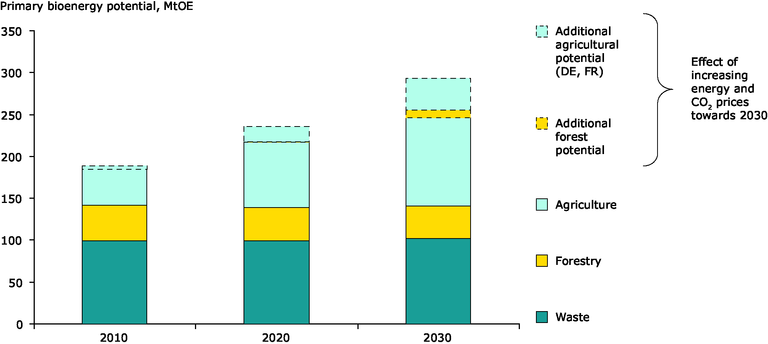All official European Union website addresses are in the europa.eu domain.
See all EU institutions and bodiesEnvironmentally-compatible primary bioenergy potential in the EU
Chart (static)
The agricultural potential comprises dedicated bioenergy crops plus cuttings from grassland and was calculated for EU-25 without Cyprus, Luxembourg and Malta

- Austria
- Belgium
- Czechia
- Denmark
- Estonia
- Finland
- France
- Germany
- Greece
- Hungary
- Ireland
- Italy
- Latvia
- Lithuania
- Netherlands
- Poland
- Portugal
- Slovakia
- Slovenia
- Spain
- Sweden
- United Kingdom
Methodology
Data are model results that were produced under the Renewables bioenergy projects (2005, 2006). Models used are: 1) For agriculture (EU-25 except Luxembourg, Cyprus, Malta): Animlib scenario of the CAPSIM model with modified yields to account for the high share of environmentally orientated farming; 2) For agriculture (Germany and France, only): HEKTOR model to estimate the CO2 permit price effect for agriculture; 3) For forestry (EU-25 except Cyprus, Greece, Luxembourg and Malta): EFISCEN model to determine the forestry residue and complementary fellings potential; 4) For forestry (EU-25): EFI-GTM model to estimate the CO2 permit price effect for forestry; 5) Waste (EU-25) projections from EEA (2005).
Additional information
Agricultural residues, such as straw and manures, are included in the category 'waste' (covering all EU-25 Member States). The forestry potential was calculated for EU-25 except Cyprus, Greece, Luxembourg and Malta. It consists of residues from fellings and complementary fellings. The additional forestry potential takes into account the reductions in the black liquor potential as a result of wood redirected from pulp and paper to energy production. It strongly depends on the assumed carbon permit and oil price. The additional agricultural potential due to higher prices paid for bioenergy was modeled only for Germany (DE), France (FR).
